
Wine Culture and Information since 2002 - Volume 22
 Wine Culture and Information since 2002 - Volume 22 |
|
Comparing Alto Adige Cabernet-MerlotAmong red wines obtained by blending different grapes and permitted by Alto Adige DOC, the combination of Cabernet-Merlot is one of the most frequent and typical ones |
|
Alto Adige, or South Tyrol, certainly is one of the most representative wine regions of Italy, a land which is famous not only for the quality of its wines, but also for the variety of grapes cultivated in vineyards. The enology of Alto Adige, besides making use of autochthonous varieties, is strongly oriented to the production of wines with grapes today considered as “international” and in most of the cases of French origin, which in this land have proven to obtain excellent results. Among red berried grapes, there is Pinot Noir, which in Alto Adige represents one of the best expressions in Italy, and the famous varieties Cabernet Sauvignon, Cabernet Franc and Merlot, grapes which made Bordeaux famous worldwide. Production disciplinary of Alto Adige DOC provides for the use and combination of different grapes, also international ones, of which the most frequent and typical one is represented by the blending of Cabernet Sauvignon and Merlot, to which is sometimes added Cabernet Franc. The union of these three grapes, usually defined as bordelais blend, is very frequent in many part of the world, a very typical combination in Alto Adige as well, producing one of the most typical red wine from international grapes of the area. Grapes of remarkable character and recognizability, Cabernet Sauvignon, Merlot and Cabernet Franc seem to be created for the production of wines result of their union, each contributing with its qualities usually completing the qualities of the others. The strength and character of Cabernet Sauvignon are in fact mitigated by the roundness and charm of Merlot, whereas Cabernet Franc contributes by adding a herbaceous hint enriching the olfactory profile of the wine and its structure. Of the three grapes, Cabernet Franc is the least used one, not only in Alto Adige but also in the rest of the world, therefore wines of the region denominated as “Cabernet-Merlot” are mainly produced with Cabernet Sauvignon and Merlot only.
|
|
Our comparative tasting will be about the study of three wines from Alto Adige produced with Cabernet Sauvignon and Merlot blended together. By following the typical style used in the production of wines with these two famous grapes, the combination Cabernet Sauvignon-Merlot is generally fermented and aged in wood containers, usually represented by the barrique, as dictated by Bordelais tradition. Indeed, the use of wood is not simply a fashion, but a necessity, as the strong character of the two grapes, in particular of Cabernet Sauvignon, benefits from the aging in wood, by smoothing the harshness of tannins and making a rounder wine. Despite the barrique is the most used container in Alto Adige for the production of Cabernet-Merlot, there are however some producers who prefer the cask instead of the French barrique, whereas other age their wines in both types of containers.
Two of the wines selected for our comparative tasting are produced by using the barrique only, whereas one of them was aged both in barrique and in cask. The first wine of our comparative tasting is Erste & Neue's Alto Adige Cabernet-Merlot Feld, aged part in barrique and part in cask, in which Cabernet Sauvignon is present in higher quantity than Merlot. The second wine is Castel Schwanburg's Alto Adige Merlot-Cabernet Sauvignon Castel Schwanburg Geierberg, produced with Merlot and Cabernet Sauvignon in equal parts and aged in barrique for 12 months. The third wine of our comparative tasting is Tiefenbrunner's Alto Adige Cabernet Merlot Cuvée Linticlarus, with the Cabernet Sauvignon present in slightly higher part than Merlot and aged in barrique for 18 months. The wines are chosen according to the most recent vintage commercialized by respective producers and will be served at the temperature of 18°C (65°F) in three ISO tasting glasses.
|
||||||||
|
Cabernet Sauvignon and Merlot are grapes both characterized by a high content in coloring substances, therefore wines produced with the union of these two varieties generally show very intense and deep colors. Also transparency is generally pretty low, sometimes with very low transparency avoiding the passage of light. Thanks to the high content in coloring substances, in Alto Adige Cabernet-Merlot wines are observed pretty intense and deep colors, of ruby red hues, which then evolve with time in garnet red. Because of the aging time in cask, in these wines it is pretty hard to see purple red colors, a typical hue in young wines and which is generally lost within few months. Also the oxidation produced by the aging in wood, as well as the contribution of tannins given by the cask, influence the color of wine, giving deeper hues. Let's begin the appearance analysis of our comparative tasting from Erste & Neue's Alto Adige Cabernet-Merlot Feld. By holding the glass tilted on a white surface, we will observe at the base of the glass the color of wine, in this case being intense ruby red, whereas the nuance - observed at the edge of the liquid mass, towards the opening of the glass - shows a garnet red. Let's now pass to the second wine: Castel Schwanburg's Alto Adige Merlot-Cabernet Sauvignon Castel Schwanburg Geierberg. By holding the glass tilted, let's observe the base - where the liquid mass is thicker - in which will be seen an intense and deep ruby red color, with nuances of the same color. We will now pass to the evaluation of the third wine - Tiefenbrunner's Alto Adige Cabernet Merlot Cuvée Linticlarus - in which will be observed an intense and deep ruby red color, with nuances showing an evident garnet red color.
|
|
Aromatic qualities of Cabernet Sauvignon and Merlot are generally well recognizable and - for many aspects - similar in the character of black and red berried fruits as well as herbaceous and vegetal aromas. Wines produced with these two grapes are in most of the cases fermented and aged in cask or barrique, therefore it will be possible to perceive pretty evident tertiary qualities, from vanilla to chocolate and cocoa, as well as balsamic aromas, generally expressed by eucalyptus. Among typical fruit aromas in Alto Adige Cabernet-Merlot are found black currant, black cherry and plum, both identifying the two grapes, whereas among flower aromas, violet is the most frequent one. With time and, of course, with the aging in wood, in these wines can also be perceived tertiary and complex aromas of coffee, chocolate, cocoa, vanilla, clover, black pepper, cinnamon, mace and licorice, whereas the most frequent vegetal aroma is bell pepper. Let's begin the evaluation of the olfactory profiles of our comparative tasting from Erste & Neue's Alto Adige Cabernet-Merlot Feld. By holding the glass in vertical position and without swirling, that is without favoring a strong oxygenation of wine, let's proceed with the first smell in order to appreciate opening aromas, that is the olfactory sensations identifying a wine and its grapes. From the glass will be perceived intense and clean aromas of black currant, plum and black cherry, three aromatic qualities which combination is very typical both in Merlot and in Cabernet Sauvignon, in particular black currant aroma. After having swirled the glass, therefore favoring the oxygenation of wine, we will proceed with the second smell in order to complete the olfactory profile of the wine. From the glass will be appreciated aromas of violet, raspberry, cyclamen, blueberry, vanilla, tobacco, coffee, cinnamon and a pleasing balsamic hint of menthol. Let's now pass to the evaluation of the second wine of our comparative tasting: Castel Schwanburg's Alto Adige Merlot-Cabernet Sauvignon Castel Schwanburg Geierberg. By holding the glass in vertical position and without swirling, let's evaluate the opening aromas expressed by black cherry, plum and black currant, just like the previous wine. After having swirled the glass, let's now proceed with the second smell in order to complete the olfactory profile with blueberry, violet, raspberry, vanilla, chocolate and licorice as well as hints of black pepper and a pleasing balsamic touch of eucalyptus. The opening of the third wine - Tiefenbrunner's Alto Adige Cabernet Merlot Cuvée Linticlarus - confirms the identifying characteristics of the two grapes with black currant, black cherry and plum. After having swirled the glass, in order to favor the development of other aromas, let's proceed with a second smell which will allow the perception of blueberry, dried violet, vanilla, tobacco, cinnamon, mace, licorice and chocolate as well as the typical balsamic touch of eucalyptus and a vegetal hint of bell pepper.
|
||||
|
Cabernet Sauvignon and Merlot are grapes generally producing wine of robust structure, when in vineyard are adopted conditions of quality viticulture and by properly processing the grapes in cellar. If it is true Cabernet Sauvignon is capable of making wines of remarkable structure and evident astringency, Merlot, despite it is capable of doing the same, is characterized for its roundness and for its smooth tannins. It is not by chance Merlot is the most used grape in enology to smooth the harshness of “hard” wines, also contributing to keep or to increase structure. Thanks to the high content in tannins found in both grapes, wines produced with Cabernet Sauvignon and Merlot are fermented and aged in cask - in most of the cases in barrique - in order to smooth the character and to make tannins less aggressive. Also the content in sugar is pretty high, therefore wines produced with these grapes will have a pretty high alcohol by volume, usually higher than 13%. Let's begin the evaluation of taste from Erste & Neue's Alto Adige Cabernet-Merlot Feld. The attack of this first wine, that is the initial sensation which can be perceived in the mouth at the first sip, is characterized by a pretty high astringency and a well structured body, sensations which are then replaced by a pleasing roundness and alcohol. Also the attack of the second wine - Castel Schwanburg's Alto Adige Merlot-Cabernet Sauvignon Castel Schwanburg Geierberg - denotes the full character of tannins of both grapes, with an evident full body and a pleasing roundness, evidencing, as opposed to the previous wine, riper and rounder tannins. Let's now pass to the evaluation of the third wine: Tiefenbrunner's Alto Adige Cabernet Merlot Cuvée Linticlarus. The attack of this wine is evidently tannic with a body having a robust and full structure, in which can be perceived the typical roundness of Merlot, also accentuated by the aging in barrique for 18 months.
|
|
The three wines of our comparative tasting fully represent the organoleptic characteristics of the two grapes, in particular the nature and strength of tannins and the typical roundness of Merlot. The finish of Erste & Neue's Alto Adige Cabernet-Merlot Feld is persistent leaving in the mouth intense and pleasing flavors of black cherry, black currant and plum, a typical finish for wines produced with these two grapes. Also the finish of Castel Schwanburg's Alto Adige Merlot-Cabernet Sauvignon Castel Schwanburg Geierberg is persistent leaving in the mouth intense and pleasing flavors of black currant, plum and black cherry, with a higher perception of structure than the previous wine. The finish of the third wine - Tiefenbrunner's Alto Adige Cabernet Merlot Cuvée Linticlarus - is not different from the previous wines, also in this case persistence is very good with flavors of black cherry, black currant and plum, although leaving in the mouth a fuller sensation of structure.
|
Wines of the Month |
|
|
|
Score legend Prices are to be considered as indicative. Prices may vary according to the country or the shop where wines are bought |

|
|
Barolo Bricat 2004 |
|
| Manzone Giovanni (Piedmont, Italy) | |
| Grapes: Nebbiolo | |
| Price: € 30.00 | Score: |
| Barolo Bricat shows a brilliant ruby red color and nuances of garnet red, moderate transparency. The nose reveals intense, clean, pleasing, refined and elegant aromas which start with hints of cherry, plum and violet followed by aromas of rose, raspberry, vanilla, tobacco, cinnamon, chocolate, mace and menthol. The mouth has good correspondence to the nose, a tannic attack and however balanced by alcohol, full body, intense flavors, pleasing roundness. The finish is persistent with flavors of cherry, plum and raspberry. A well made wine. Barolo Bricat ages for 24 months in cask. | |
| Food Match: Game, Roasted meat, Braised and stewed meat, Hard cheese | |

|
|
Barolo Riserva Le Gramolere 2000 |
|
| Manzone Giovanni (Piedmont, Italy) | |
| Grapes: Nebbiolo | |
| Price: € 43.50 | Score: |
| Barolo Riserva Le Gramolere shows a brilliant ruby red color and nuances of garnet red, moderate transparency. The nose reveals intense, clean, pleasing, refined and elegant aromas which start with hints of cherry, plum and dried violet followed by aromas of raspberry jam, strawberry jam, dried rose, vanilla, tobacco, licorice, leather, cocoa, clover, mace and menthol. The mouth has excellent correspondence to the nose, a tannic attack and however balanced by alcohol, full body, intense flavors, pleasing roundness. The finish is very persistent with long flavors of cherry, plum and raspberry jam. Barolo Riserva Le Gramolere ages for 36 months in cask. | |
| Food Match: Game, Roasted meat, Stewed and braised meat, Hard cheese | |
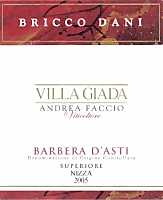
|
|
Barbera d'Asti Superiore Nizza Bricco Dani 2005 |
|
| Villa Giada (Piedmont, Italy) | |
| Grapes: Barbera | |
| Price: € 19.00 | Score: |
| Barbera d'Asti Superiore Nizza Bricco Dani shows an intense ruby red color and nuances of ruby red, little transparency. The nose reveals intense, clean, pleasing and refined aromas which start with hints of cherry, plum and blueberry followed by aromas of violet, tobacco, vanilla, pink pepper, chocolate, mace and menthol. The mouth has good correspondence to the nose, a tannic attack and however balanced by alcohol, good body, intense flavors, agreeable. The finish is persistent with flavors of cherry, plum and blueberry. Barbera d'Asti Superiore Nizza Bricco Dani ages for more than one year in barrique. | |
| Food Match: Roasted meat, Braised and stewed meat with mushrooms, Hard cheese | |
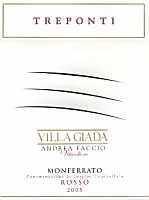
|
|
Monferrato Rosso Treponti 2005 |
|
| Villa Giada (Piedmont, Italy) | |
| Grapes: Nebbiolo, Barbera | |
| Price: € 12.50 | Score: |
| Monferrato Rosso Treponti shows an intense ruby red color and nuances of ruby red, little transparency. The nose denotes intense, clean, pleasing and refined aromas which start with hints of black cherry, plum and blueberry followed by aromas of violet, vanilla, blackberry, tobacco, pink pepper, chocolate, mace and menthol. The mouth has good correspondence to the nose, a tannic attack and however balanced by alcohol, good body, intense flavors, pleasing roundness. The finish is persistent with flavors of plum, black cherry and blueberry. Monferrato Rosso Treponti ages for about 12 months in barrique. | |
| Food Match: Roasted meat, Stewed and braised meat, Hard cheese | |
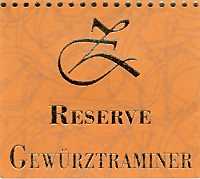
|
|
Alto Adige Gewürztraminer Reserve 2006 |
|
| Peter Zemmer (Alto Adige, Italy) | |
| Grapes: Gewürztraminer | |
| Price: € 12.90 | Score: |
| Alto Adige Gewürztraminer Reserve shows a pale golden yellow color and nuances of golden yellow, very transparent. The nose denotes intense, clean, pleasing and refined aromas that start with hints of grape, litchi and white rose followed by aromas of peach, pear, apple, banana, honey, citrus fruit peel and sage. The mouth has good correspondence to the nose, a crisp attack and however balanced by alcohol, good body, intense flavors, pleasing roundness. The finish is persistent with flavors of grape, banana and litchi. Alto Adige Gewürztraminer Reserve ages in steel tanks. | |
| Food Match: Pasta and risotto with fish and crustaceans, Broiled crustaceans, Roasted white meat | |
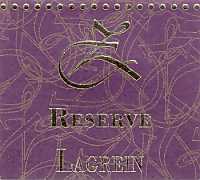
|
|
Alto Adige Lagrein Reserve 2006 |
|
| Peter Zemmer (Alto Adige, Italy) | |
| Grapes: Lagrein | |
| Price: € 13.90 | Score: |
| Alto Adige Lagrein Reserve shows an intense ruby red color and nuances of ruby red, little transparency. The nose reveals intense, clean, pleasing and refined aromas which start with hints of black cherry, blueberry and blackberry followed by aromas of violet, plum, vanilla, cocoa, mace and menthol. The mouth has good correspondence to the nose, a tannic attack and however balanced by alcohol, good body, intense flavors, pleasing roundness. The finish is persistent with flavors of black cherry, blueberry and blackberry. Alto Adige Lagrein Reserve ages for 15 months in barrique, 10 months in cask and for 6 months in bottle. | |
| Food Match: Roasted meat, Stewed and braised meat, Hard cheese | |
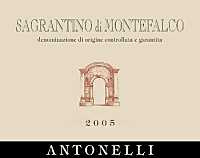
|
|
Sagrantino di Montefalco 2005 |
|
| Antonelli (Umbria, Italy) | |
| Grapes: Sagrantino | |
| Price: € 25.00 | Score: |
| This Sagrantino di Montefalco shows an intense ruby red color and nuances of ruby red, little transparency. The nose reveals intense, clean, pleasing, refined and elegant aromas which start with hints of black cherry, blackberry and plum followed by aromas of violet, blueberry, cinnamon, cyclamen, vanilla, mace, chocolate, tobacco and menthol. The mouth has good correspondence to the nose, a tannic attack and however balanced by alcohol, full body, intense flavors, pleasing roundness. The finish is persistent with flavors of black cherry, blackberry and plum. This Sagrantino di Montefalco ages for 15 months in cask followed by 6 months of aging in bottle. | |
| Food Match: Game, Roasted meat, Stewed and braised meat, Hard cheese | |
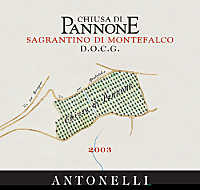
|
|
Sagrantino di Montefalco Chiusa di Pannone 2003 |
|
| Antonelli (Umbria, Italy) | |
| Grapes: Sagrantino | |
| Price: € 36.00 | Score: |
| Sagrantino di Montefalco Chiusa di Pannone shows an intense ruby red color and nuances of ruby red, little transparency. The nose denotes intense, clean, pleasing, refined and elegant aromas that start with hints of black cherry, blackberry and plum followed by aromas of blueberry, violet, vanilla, cinnamon, chocolate, mace, pink pepper, tobacco and menthol. The mouth has good correspondence to the nose, a tannic attack and however balanced by alcohol, full body, intense flavors, agreeable. The finish is persistent with flavors of black cherry, blackberry and plum. A well made wine. Sagrantino di Montefalco Chiusa di Pannone ages for 21 months in cask, 3 months in cement tanks and for two years in bottle. | |
| Food Match: Game, Roasted meat, Stewed and braised meat, Hard cheese | |
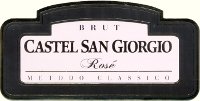
|
|
Oltrepo Pavese Metodo Classico Brut Rosé Castel San Giorgio 2005 |
|
| Podere San Giorgio (Lombardy, Italy) | |
| Grapes: Pinot Noir (90%), Chardonnay (10%) | |
| Price: € 18.00 | Score: |
| Oltrepo Pavese Metodo Classico Brut Rosé Castel San Giorgio shows a brilliant onion skin pink color and nuances of onion skin pink, very transparent, fine and persistent perlage. The nose denotes intense, clean, pleasing and refined aromas which start with hints of cherry, raspberry and yeast followed by aromas of strawberry, tangerine, plum, carnation, cyclamen and bread crust. The mouth has good correspondence to the nose, a crisp and effervescent attack, however balanced by alcohol, good body, intense flavors, pleasing roundness. The finish is persistent with flavors of cherry, raspberry and strawberry. Oltrepo Pavese Metodo Classico Brut Rosé Castel San Giorgio referments in bottle for 11 months. | |
| Food Match: Aperitifs, Meat and fish appetizers, Pasta with fish, Sauteed fish | |

|
|
Valtellina Superiore Sassella Riserva 2004 |
|
| Rainoldi (Lombardy, Italy) | |
| Grapes: Nebbiolo | |
| Price: € 18.00 | Score: |
| Valtellina Superiore Sassella Riserva shows a brilliant ruby red color and nuances of garnet red, moderate transparency. The nose denotes intense, clean, pleasing and refined aromas that start with hints of cherry, raspberry and plum followed by aromas of violet, strawberry, rose, vanilla, tobacco, cinnamon, cocoa and menthol. The mouth has good correspondence to the nose, a tannic attack and however balanced by alcohol, full body, intense flavors, pleasing roundness. The finish is persistent with flavors of cherry, plum and raspberry. Valtellina Superiore Sassella Riserva ages for 2 years in cask. | |
| Food Match: Game, Roasted meat, Stewed and braised meat, Hard cheese | |

|
|
Valtellina Sfursat Fruttaio Ca' Rizzieri 2004 |
|
| Rainoldi (Lombardy, Italy) | |
| Grapes: Nebbiolo | |
| Price: € 32.00 | Score: |
| Valtellina Sfursat Fruttaio Ca' Rizzieri shows a brilliant ruby red color and nuances of garnet red, moderate transparency. The nose reveals intense, clean, pleasing, refined and elegant aromas which start with hints of cherry, plum and violet followed by aromas of raspberry, strawberry, rose, vanilla, tobacco, cinnamon, chocolate, leather, mace and menthol. The mouth has excellent correspondence to the nose, a tannic attack and however balanced by alcohol, full body, intense flavors, pleasing roundness. The finish is very persistent with long flavors of cherry, plum and raspberry. A well made wine. Valtellina Sfursat Fruttaio Ca' Rizzieri ages for 15 months in barrique followed by more than 12 months of aging in bottle. | |
| Food Match: Game, Roasted meat, Stewed and braised meat, Hard cheese | |
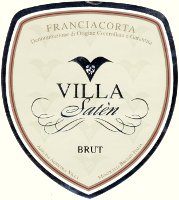
|
|
Franciacorta Satèn Brut 2005 |
|
| Villa (Lombardy, Italy) | |
| Grapes: Chardonnay | |
| Price: € 21.00 | Score: |
| Franciacorta Satèn Brut shows a pale straw yellow color and nuances of greenish yellow, very transparent, fine and persistent perlage. The nose denotes intense, clean, pleasing and refined aromas which start with hints of banana, apple and bread crust followed by aromas of acacia, hazelnut, yeast, pear, plum, hawthorn and butter. The mouth has good correspondence to the nose, a crisp and effervescent attack, however balanced by alcohol, good body, intense flavors, pleasing roundness. The finish is persistent with flavors of banana, apple and plum. Franciacorta Satèn Brut referments for at least 30 months in bottle. | |
| Food Match: Aperitifs, Risotto with fish and crustaceans, Sauteed crustaceans, Vegetables | |
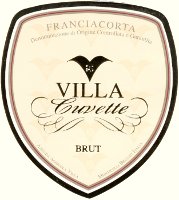
|
|
Franciacorta Cuvette Brut 2004 |
|
| Villa (Lombardy, Italy) | |
| Grapes: Chardonnay (80%), Pinot Noir (15%), Pinot Blanc (5%) | |
| Price: € 22.00 | Score: |
| Franciacorta Cuvette Brut shows a pale straw yellow color and nuances of straw yellow, very transparent, fine and persistent perlage. The nose reveals intense, clean, pleasing, refined and elegant aromas which start with hints of banana, pear and tangerine followed by aromas of bread crust, yeast, acacia, hawthorn, apple, hazelnut, plum, broom, butter and hints of vanilla. The mouth has good correspondence to the nose, an effervescent and crisp attack, however balanced by alcohol, good body, intense flavors, pleasing roundness. The finish is persistent with flavors of banana, apple and plum. A well made wine. Franciacorta Cuvette Brut referments in bottle for at least 42 months. | |
| Food Match: Roasted fish, Roasted white meat, Pasta with fish and meat | |
|
||||||||
|
DiWineTaste Polls
|
| |||||||
Privacy Policy | |||||||


| Copyright © 2002-2024 Antonello Biancalana, DiWineTaste - All rights reserved |
| All rights reserved under international copyright conventions. No part of this publication and of this WEB site may be
reproduced or utilized in any form or by any means, electronic or mechanical, without permission in writing from DiWineTaste. |